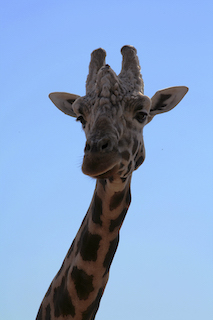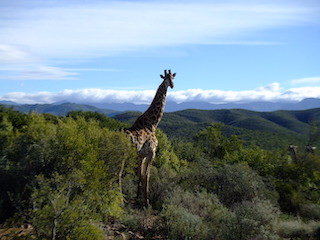10 Questions About Psychoticism Of Giraffes
Giraffes are among the most majestic and iconic creatures in the animal kingdom. They have towering height, distinctive long necks, and gentle demeanour. Hence, they have long captured the fascination of people around the world. Despite their widespread popularity, giraffes remain mysterious to many. Therefore, there are still a lot of common questions about these graceful giants. In this article, we will explore 10 frequently asked questions about giraffes. Through them, we will uncover interesting facts about their biology, behaviour, and unique traits. We will also delve into how giraffes’ behaviour relates to psychological concepts like psychoticism. It will offer insights into the broader human-animal connection.
1) What is psychoticism and how does it relate to giraffes?
In the realm of psychology, psychoticism is a personality trait. It relates to a person’s tendency toward aggression, impulsiveness, and a lack of empathy. The concept of psychoticism connects with human behaviour. But it is interesting to consider how certain animal behaviours come across through a psychological lens. Giraffes, in comparison to many other large animals, are not generally aggressive creatures. They exhibit calm, docile behaviours and have peaceful interactions with one another. However, during mating seasons, male giraffes may engage in combat. They use their long necks and heads to deliver powerful necking blows to one another. This can be seen as an expression of competition or dominance. But it is not an indication of psychoticism, as these behaviours are instinctive. They are usually not aggressive in the context of a true psychotic personality.
Psychoticism in animals can sometimes manifest in unpredictable or extreme behaviors, but giraffes’ behavior is generally marked by calmness and cooperation, especially in herds. Giraffes also exhibit strong social bonds and communicate with each other through body language and vocalisations, suggesting that their temperament leans more toward the peaceful end of the behavioural spectrum, with occasional instances of competition.
2) How tall do giraffes get?
Giraffes are the tallest land animals on earth, and their height is one of the most striking features about them. Adult male giraffes, also known as bulls, typically grow to be about 16 to 18 feet tall, while females are generally a bit shorter, ranging between 14 and 16 feet in height. A giraffe’s long neck, which can be up to 6 feet long, is a major factor in their towering stature. Interestingly, giraffes’ necks have only seven vertebrae, the same number as most mammals, including humans, though each vertebra is much longer than in other species.
3) Do giraffes sleep standing up?
Yes, giraffes typically sleep standing up, but they do take short naps while standing. Unlike many animals that lie down to sleep, giraffes’ size and physiology make lying down for long periods of time difficult. Sleeping while standing helps giraffes stay alert to potential threats from predators in the wild, such as lions or hyenas. However, giraffes also do sleep lying down occasionally, especially when they are in a safe environment or feel secure. Their sleep is generally brief, lasting only about 10 to 30 minutes at a time, and they usually take multiple naps throughout a 24-hour period.
4) Why do giraffes have long necks?
The giraffe’s long neck is perhaps its most distinctive feature, and it serves several important purposes. One of the primary reasons giraffes evolved to have such long necks is for browsing on trees and shrubs that are out of reach for most other herbivores. This allows giraffes to access food sources that are not available to other species, giving them a distinct advantage in environments with abundant tall trees.
In addition to feeding purposes, long necks also play a crucial role in giraffe mating behavior. Male giraffes engage in necking battles, where they swing their necks at each other and use their heads like hammers to deliver blows to their opponents. The male who delivers the most powerful hits usually wins the right to mate with a female. This behaviour, though non-lethal, helps determine dominance within giraffe herds and plays a critical role in their social structure.
5) What do giraffes eat?
Giraffes are herbivores and primarily eat leaves, fruits, and flowers from trees. Their long necks allow them to reach vegetation that other animals can’t access. Acacia trees are one of their favorite food sources, but they will also feed on a variety of shrubs and bushes. Giraffes are selective feeders, often picking out the tender leaves from the top of trees. They use their long, prehensile tongues, which can be up to 18 inches long, to grasp and strip leaves from branches.
Because giraffes’ diets are mostly made up of leaves, they get most of their water from the food they eat. However, they do need to drink water occasionally. When drinking, giraffes must spread their legs wide apart and bend down awkwardly to reach the water, a posture that makes them vulnerable to predators. This is why they generally prefer to drink in the early morning or late evening when the risk of encountering predators is lower.
6) How fast can giraffes run?
Despite their large size and long legs, giraffes are surprisingly fast runners. Giraffes can reach speeds of up to 35 miles per hour in short bursts. However, they are not built for endurance running, and they tend to run only when absolutely necessary, such as when they are trying to escape a predator. When giraffes are cruising at a moderate pace, they can move at speeds of around 10 miles per hour. Their long strides allow them to cover ground quickly, even though their movements appear graceful and deliberate.
7) How long do giraffes live?
In the wild, giraffes typically live to be about 25 years old, though some can live a bit longer under optimal conditions. In captivity, where threats from predators are nonexistent and medical care is readily available, giraffes can live to be around 30 years old or more. However, their lifespan can be significantly affected by various factors such as habitat loss, poaching, and predation. Giraffes face significant challenges in the wild, particularly in regions where their natural habitat is threatened by human activities.
8) Do giraffes have any natural predators?
Yes, giraffes do have natural predators, though due to their size and stature, they are not as vulnerable as smaller herbivores. The main predators of giraffes are large carnivores such as lions, hyenas, and wild dogs. However, because giraffes are so tall, they have a good vantage point and are able to spot predators from a distance. Their long legs allow them to run quickly when necessary, and when faced with a threat, they will often attempt to escape. In cases where a giraffe is caught off guard, they may defend themselves by delivering powerful kicks to potential predators. A giraffe’s kick is strong enough to injure or kill a lion, and this self-defence mechanism is a key reason why giraffes are difficult prey.
9) How do giraffes communicate?
Giraffes communicate using a variety of methods, though their communication is often subtle and non-verbal. One of the most common ways giraffes communicate is through body language. They use their heads, necks, and tails to convey messages to one another. For example, a giraffe may swing its head back and forth to signal dominance or assert its position within the herd. Giraffes also communicate through vocalizations, though these sounds are typically low-frequency and infrequent. These vocalisations include grunts, snorts, and the occasional mooing noise, which is most commonly heard when giraffes are startled or alarmed.
10) Are giraffes in danger?
Giraffes are classified as a species of least concern by the International Union for conservation of nature at a global level. However, there are specific giraffe subspecies that are vulnerable or endangered. The Reticulated giraffe, for example, has seen a significant population decline in recent decades, primarily due to habitat loss, poaching, and human-wildlife conflict. Conservation efforts are underway to protect giraffes and their habitats, including establishing wildlife reserves and working with local communities to reduce poaching and habitat destruction.
Wonders of giraffes
Giraffes are extraordinary creatures that captivate our imaginations with their graceful movements, towering presence, and gentle nature. By answering these frequently asked questions about giraffes, we have uncovered some of the key aspects of their biology, behavior, and ecology. From their long necks to their ability to run fast despite their size, giraffes are full of surprises.
While giraffes do not exhibit the traits associated with psychoticism in humans, understanding the psychological behaviors of animals can help us appreciate the complexity of their lives. By learning more about giraffes, we deepen our connection to the natural world. We also gain insights into how these magnificent animals navigate their environment. Let us continue to protect giraffes and their habitats. That way, we can ensure that we pass on the legacy to future generations. They will also be able to witness the majesty of these remarkable creatures for years to come.





